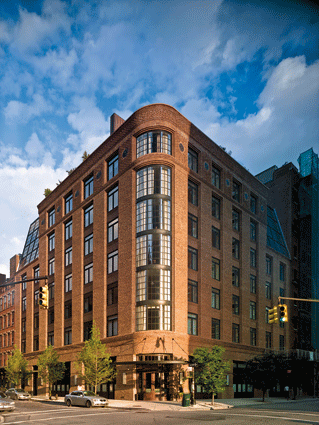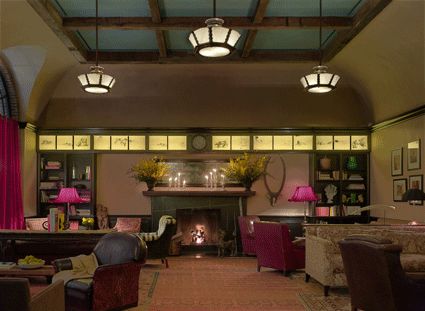It was my first visit to New York and, like so many before me, I felt like I was on a film set. The landmarks, neon lights and flow of human traffic provided such a strong sense of deja vu. So it was perhaps fitting that my first few nights in the Big Apple were spent in an area that has become intrinsically linked with the film industry, and in a hotel co-owned by one of the industry’s biggest names, Robert De Niro.
The Greenwich Hotel lies at the corner of Greenwich Street and North Moore Street, in the neighbourhood of Tribeca. Eight stories of hand-cut bricks, it has become a refuge for filmmakers, actors and others looking for privacy and quiet in the heart of Downtown Manhattan.
Tribeca’s name derives from ‘Triangle Beneath Canal Street’ and the area was for many years characterised by its cobbled streets – the hotel offers a complimentary shoeshine service to remove any scuffs – and a profusion of abandoned warehouses. But it has gone through something of a renaissance and is now considered one of New York’s hottest areas, with artists and celebrities taking up residence in the big loft spaces.
De Niro – referred to by some as Tribeca’s de facto mayor – has been a key figure in the area’s resurgence, through a number of business ventures. He first came to the area while looking for somewhere to set up a gym while filming Raging Bull. And he’s had ties with it ever since. He co-founded the Tribeca Film Center in an old coffee warehouse, which was soon followed by a restaurant, the Tribeca Grill. Then in 2002 he founded the Tribeca Film Festival, in an attempt to restore some of the area’s lost vitality after the September 11 attacks – Ground Zero is just a few minutes’ walk down Greenwich Street.
New York may be the city that never sleeps, but the 88 guest rooms and suites at the Greenwich oppose that mantra. My Superior Greenwich Room has a super kingsize bed, generous pillows and a large headrest that encourage deep, contented sleep. There’s a comfy armchair and ottoman beside a window overlooking Greenwich Street, with a leather Beaumont & Fletcher couch to the side.
Although no two rooms are alike, they are all furnished with a Tibetan silk or antique rug – mine showing the motif of a strutting peacock. The ensuite walk-in rain shower, with Carrara marble on the floor, is a further nod to an appreciation of handicrafts from around the world. Other rooms have Moroccan tiles.
The 13 suites are even more lavish, coming with private saunas and working fireplaces. Two duplex suites feature soaring skylights and chef’s kitchens, while the Penthouse includes its own media complex and a rooftop garden with views of the Hudson River.
The general guest rooms have some good modern touches of their own, with large flat-screen televisions and Bose docking stations by the bed, for use with complimentary hotel iPods. The minibar is also complimentary for non-alcoholic drinks, which makes a pleasant change to the norm. Guests can also tuck in to treats such as Uncle Jerry’s Homemade Pennsylvania Dutch pretzels and Nestle Butterfingers, from jars dotted around the room.
The hotel’s best treasure, however, is located in the basement: a swimming pool and lounge area lit by lanterns and housed within the frame of a 250-year-old ryokan-style Japanese farmhouse. The pool is the centrepiece of the hotel’s Shibui Spa, which takes its name from the Japanese for ‘a subtle and unobtrusive approach’ – a concept it took seriously enough to transport the wood and bamboo from Kyoto, employing 13 Japanese craftsmen to reconstruct it in this funky part of Manhattan. No nails were used in its construction, and the highly-skilled craftsmen are known as ‘living treasures’ in Japan for their knowledge of traditional knot-tying techniques. Tranquil music plays in the low light as I enjoy a swim beneath these wonderful old beams, and for a while I forget the big city is outside.
There’s also a gym, should any guests succumb to New York’s penchant for vigorous daily exercise – which is well demonstrated when I go to stretch my legs by the nearby West Side Highway, where a narrow strip of park runs beside the Hudson River. A cool breeze drifts in from the water, ruffling the hair of joggers, cyclists, and dog-walkers with tiny pristine pets on leads.
The Greenwich is pet friendly, welcoming guests ‘whatever their species’. Pitching myself somewhere between dog-walker and Raging Bull, I enjoy a few ‘Raging Dog’ ales in the Greenwich’s pretty courtyard, where the gentle chatter of New Yorkers enjoying pre-dinner drinks sounds beneath latticed vines. Windows on one side of the courtyard look through to the Locanda Verde restaurant, an airy and evidently very popular eatery with outdoor café seating on Greenwich Street in the summer.
The courtyard also connects to a drawing room via custom-made French doors: the mirrored glass in these was salvaged from New York’s Flatiron Building. The drawing room has a high ceiling and a roaring fire topped by a thick mantelpiece on top of which stand candles with long streaks of dried wax. On either side of the fireplace are curiosities from around the world: wall-mounted ibex horns and Japanese-style drawings of elephants among them. It feels like a discreet members’ club, with leather chairs in the lounge and interesting works of art on show.
Art features in the lobby and on a wall behind the check-in desk, as well. Several paintings are signed with a distinctive ‘De Niro’ – not the signature of the famous actor, however, but of his late father, Robert senior, a well-known Abstract Expressionist. Jackson Pollock and other cultural figures, including Tennessee Williams, were visitors to Robert senior’s Greenwich Village loft in the 1940s and 50s – and this upbringing clearly galvanised Robert junior’s love of art.
I think about capturing this artistic spirit with my camera, but suspect that photography is forbidden here. Art may be precious, but privacy and anonymity are, I sense, just as much of a luxury for some of the guests, here at the Greenwich.











